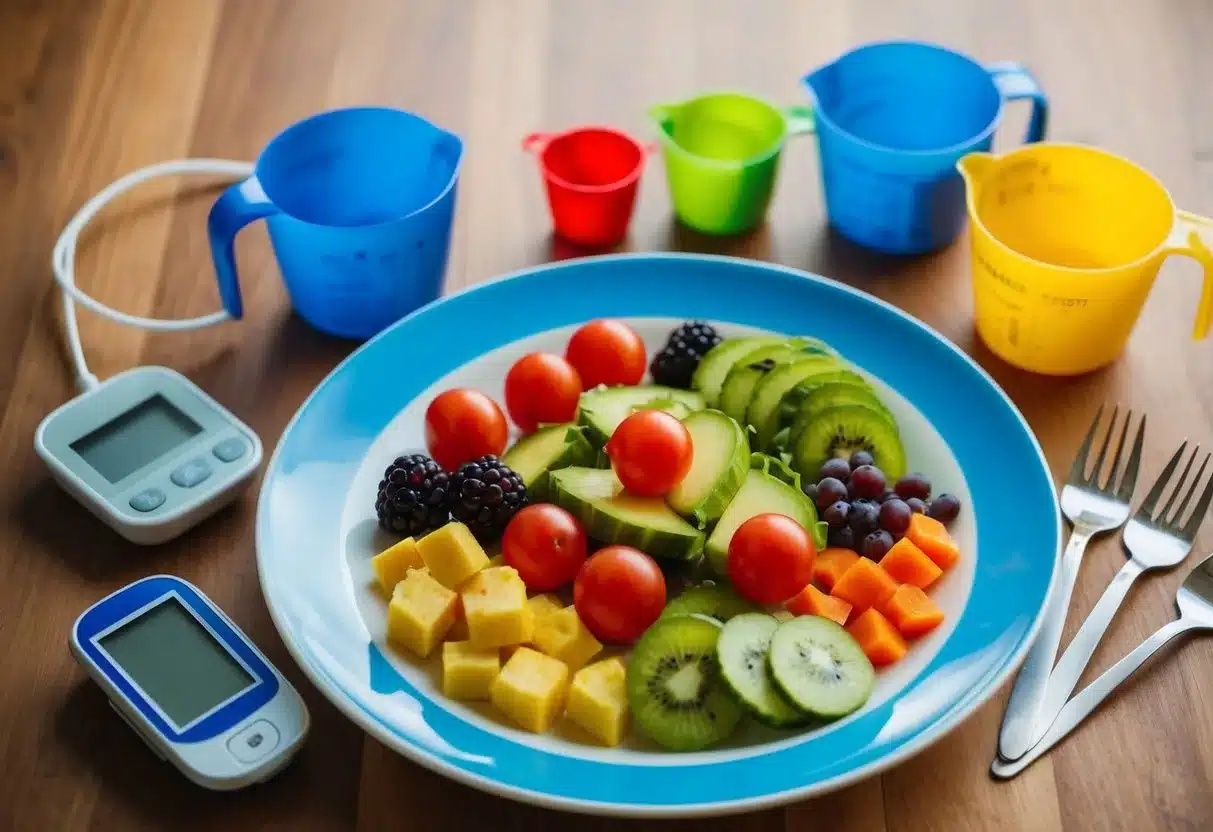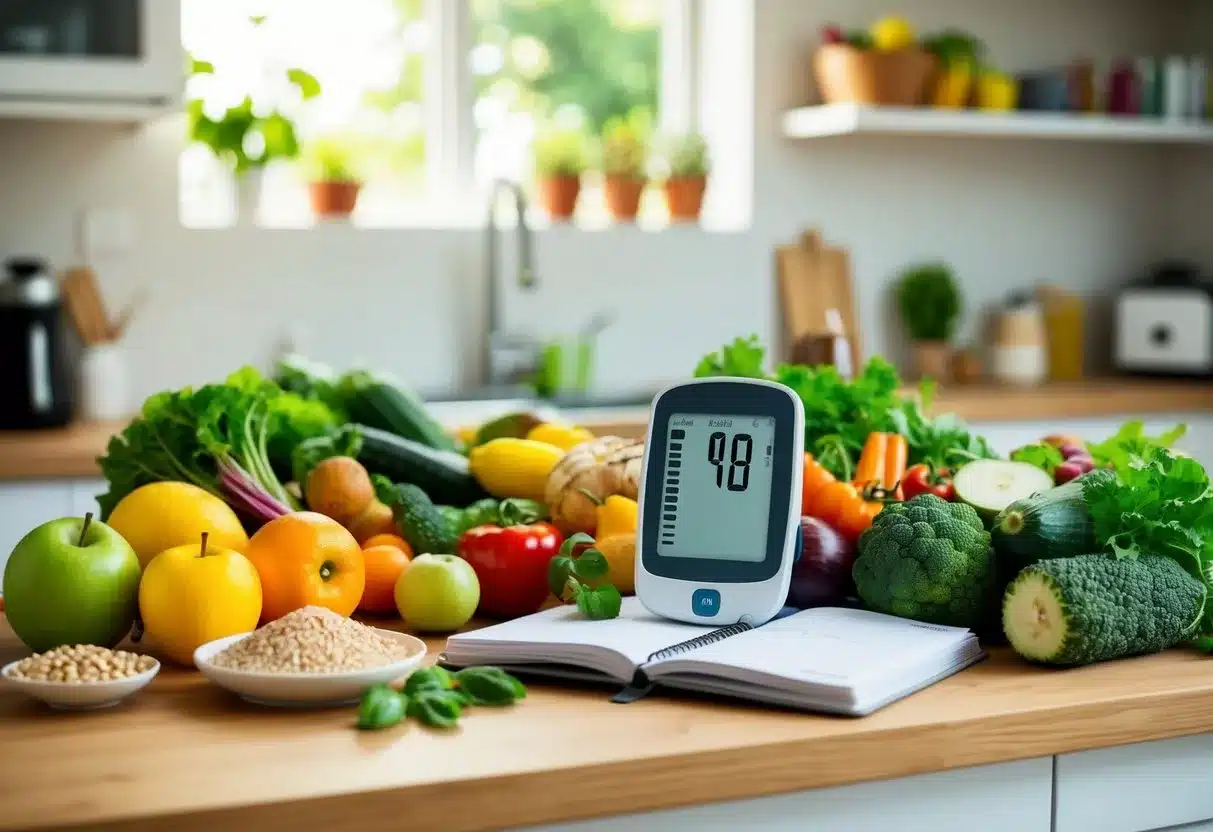Natural Lifestyle Changes for Blood Sugar Management
Living with diabetes can be challenging, but it’s possible to manage the condition without relying solely on medication. Many people with type 2 diabetes have found success in controlling their blood sugar levels through lifestyle changes and natural methods. Making smart food choices, staying active, and maintaining a healthy weight can significantly improve insulin sensitivity and help keep blood glucose in check.

Adopting a balanced diet rich in fiber, lean proteins, and healthy fats is key to managing diabetes naturally. Regular exercise, such as walking or swimming, can also boost the body’s ability to use insulin effectively. Getting enough sleep and managing stress are important factors too, as they can impact blood sugar levels.
It’s crucial to work closely with a healthcare provider when making changes to diabetes management. Regular monitoring of blood glucose levels and A1C tests help track progress and ensure safety. While some people may be able to control diabetes without medication, others might need a combination of lifestyle changes and medical treatment for optimal health.
Key Takeaways
- Diet, exercise, and weight management play crucial roles in controlling blood sugar.
- Regular monitoring and healthcare provider guidance ensure safe diabetes management.
- Lifestyle changes can improve insulin sensitivity and potentially reduce medication needs.
Understanding Diabetes

Diabetes is a chronic condition that affects how the body processes glucose. It involves issues with insulin production or function, leading to high blood sugar levels. This can cause various health complications if left unmanaged.
Types of Diabetes and Their Differences
There are two main types of diabetes: type 1 and type 2. Type 1 diabetes is an autoimmune condition where the body’s immune system attacks insulin-producing cells in the pancreas. People with type 1 diabetes need insulin injections to survive.
Type 2 diabetes is more common. It occurs when the body becomes resistant to insulin or doesn’t produce enough. This type is often linked to lifestyle factors and can sometimes be managed without medication.
Type 2 diabetes treatment may include lifestyle changes and medications to control blood sugar levels.
The Role of Insulin in Blood Sugar Regulation
Insulin is a hormone made by the pancreas. It helps cells absorb glucose from the bloodstream, lowering blood sugar levels. In people without diabetes, insulin production increases after eating to handle the rise in blood glucose.
When someone has diabetes, this process doesn’t work properly. In type 1 diabetes, there’s little or no insulin production. In type 2 diabetes, cells may not respond well to insulin (insulin resistance).
This leads to high blood sugar levels (hyperglycemia). Over time, high blood sugar can damage various organs and tissues in the body.
Recognizing Symptoms and Risks of Uncontrolled Diabetes
Common symptoms of diabetes include:
- Increased thirst and frequent urination
- Blurred vision
- Unexplained weight loss
- Slow-healing wounds
- Fatigue
If left uncontrolled, diabetes can lead to serious complications such as heart disease, kidney damage, and nerve problems. Regular blood sugar monitoring and proper management are crucial to prevent these issues.
Risk factors for type 2 diabetes include obesity, family history, age over 45, and certain ethnicities. Maintaining a healthy lifestyle can help reduce these risks and manage diabetes effectively.
The Power of Diet in Managing Diabetes

Diet plays a crucial role in controlling blood sugar levels for people with diabetes. A well-planned eating approach can help manage glucose, reduce complications, and improve overall health.
Balancing Macronutrients for Blood Sugar Control
Carbohydrates have the biggest impact on blood sugar. Focusing on complex carbs from whole grains, beans, and vegetables can help maintain steady glucose levels. These foods are high in fiber and nutrients.
Protein and healthy fats are also important. They slow digestion and help prevent blood sugar spikes. Good protein sources include lean meats, fish, and plant-based options like lentils.
Healthy fats from foods like olive oil, nuts, and avocados can improve insulin sensitivity. A balanced diet with the right mix of carbs, protein, and fats is key for blood sugar control.
Limiting processed foods, added sugars, and simple carbs is crucial. These can cause rapid glucose spikes. Instead, focus on whole, nutrient-dense foods.
The Importance of Fiber in the Diabetic Diet
Fiber is a powerhouse for diabetes management. It slows digestion and helps prevent blood sugar spikes after meals. Aim for 25-30 grams of fiber daily from a variety of sources.
Soluble fiber is especially beneficial. It forms a gel-like substance that slows glucose absorption. Good sources include oats, barley, and legumes.
Insoluble fiber aids digestion and helps with weight management. It’s found in whole grains, nuts, and many vegetables. Non-starchy veggies like broccoli and spinach are excellent choices.
A high-fiber diet can improve blood sugar control and reduce the risk of heart disease. It also promotes feelings of fullness, which can help with weight management.
Lifestyle Measures to Improve Insulin Sensitivity

Making certain changes to your daily habits can help boost how well your body responds to insulin. This can lead to better blood sugar control without medication.
Optimizing Physical Activity for Better Glucose Metabolism
Regular exercise is key for improving insulin sensitivity. Aim for at least 150 minutes of moderate activity each week. This can include brisk walking, swimming, or cycling.
Try to mix cardio with strength training. Lifting weights or using resistance bands helps build muscle. More muscle means better blood sugar control.
High-intensity interval training (HIIT) can be very effective. It involves short bursts of intense exercise followed by rest periods. HIIT can improve insulin function quickly.
Remember to start slow if you’re new to exercise. Gradually increase the intensity and duration of your workouts over time.
Weight Loss Strategies for Enhanced Insulin Function
Losing extra weight can greatly improve how insulin works in your body. Even a small weight loss of 5-10% can make a big difference.
Focus on eating whole, unprocessed foods. Fill your plate with vegetables, lean proteins, and healthy fats. Limit sugary and high-carb foods that can spike blood sugar.
Try eating smaller meals more often throughout the day. This can help keep blood sugar levels steady.
Drinking water instead of sugary drinks can help with weight loss. Aim for 8 glasses a day.
Strategies for Quality Sleep and Diabetes Management
Getting enough sleep is crucial for managing blood sugar levels. Aim for 7-9 hours of sleep each night.
Create a relaxing bedtime routine. This might include reading, gentle stretching, or meditation. Try to go to bed and wake up at the same times each day.
Keep your bedroom cool, dark, and quiet. Use comfortable bedding and pillows to promote better sleep.
Limit screen time before bed. The blue light from phones and tablets can make it harder to fall asleep. Try to avoid caffeine and big meals close to bedtime.
Routine and Monitoring for Stabilizing Blood Sugar

Regular exercise and blood sugar checks are key for managing diabetes without medication. These habits help keep glucose levels steady and in a healthy range.
Designing an Exercise Routine for Consistency
A good exercise plan mixes different types of activities. Aim for 30 minutes of moderate exercise 5 days a week. This could be brisk walking, swimming, or biking.
Add strength training 2-3 times weekly. Lift weights or do bodyweight exercises like push-ups and squats. This builds muscle, which helps control blood sugar.
Start slow if you’re new to exercise. Gradually increase time and intensity. Always check your blood sugar before and after workouts.
Try to be active throughout the day. Take short walks during breaks. Use stairs instead of elevators. Small movements add up and help manage glucose levels.
The Importance of Regular Blood Sugar Monitoring
Checking blood sugar regularly gives you vital info about your health. Use a glucometer to test at home. This small device measures glucose from a tiny drop of blood.
Test your fasting blood sugar first thing in the morning. This shows your baseline level before eating. Also check before meals and 2 hours after. This tells you how food affects your glucose.
Keep a log of your readings. Note what you ate and any exercise. This helps spot patterns. You can then adjust your diet or activity to improve your numbers.
Talk to your doctor about how often to test. They may suggest more checks if your levels are unsteady.
Behavioral Adjustments for Long-Term Diabetes Control

Making key lifestyle changes can help manage blood sugar levels without medication. Reducing stress and quitting harmful habits are two important steps for long-term diabetes control.
The Impact of Stress on Blood Sugar Levels
Stress can cause blood glucose to rise. When stressed, the body releases hormones that can interfere with insulin’s ability to work properly. Managing stress is crucial for diabetes control.
Some effective stress management techniques include:
- Deep breathing exercises
- Meditation or mindfulness practice
- Regular physical activity
- Getting enough sleep
- Talking to a therapist or counselor
Keeping a stress journal can help identify triggers. This allows a person to develop coping strategies for stressful situations.
Quitting Harmful Habits for Diabetes Prevention
Certain habits can make diabetes worse over time. Quitting smoking is one of the most important steps. Smoking increases insulin resistance and the risk of diabetes complications.
Other habits to avoid:
- Drinking sugary beverages
- Excessive alcohol consumption
- Skipping meals
- Eating large portions
Replacing these habits with healthier choices is key. Drinking water instead of soda or using apple cider vinegar in recipes can be beneficial. Small, consistent changes lead to better blood sugar control over time.
Natural Remedies and Supplements

Some natural approaches may help manage blood sugar levels without medication. These include dietary changes and staying hydrated. Let’s explore specific herbs, supplements, and hydration strategies that show promise.
Integrating Herbal and Natural Supplements in Your Routine
Certain herbs and supplements may aid in blood sugar control. Garlic has shown potential to improve insulin sensitivity and lower blood sugar in some studies. Cinnamon is another spice that might help reduce fasting blood glucose.
Probiotics support gut health and may improve glucose metabolism. Foods rich in probiotics include yogurt, kefir, and sauerkraut.
High-fiber foods can slow sugar absorption. Oatmeal is an excellent choice, as it’s high in soluble fiber. Other options include beans, lentils, and vegetables.
It’s important to consult a healthcare provider before starting any new supplements. They can interact with medications or have side effects.
Effect of Hydration on Blood Sugar Levels
Proper hydration plays a key role in blood sugar management. Drinking water before meals may help lower blood sugar. It can also reduce calorie intake, aiding in weight management.
Aim for 8-10 glasses of water daily. Avoid sugary drinks like soda, which can cause blood sugar spikes.
Apple cider vinegar mixed with water may help lower fasting blood sugar when consumed before bed. Start with 1-2 tablespoons in a glass of water.
Remember, while these strategies can help, they don’t replace medical advice. Always work with a healthcare provider to manage diabetes effectively.
Eating Patterns and Meal Planning

Proper meal planning and eating patterns play a big role in managing diabetes without medication. The right food choices and timing can help keep blood sugar levels stable throughout the day.
The Role of Meal Timing and Frequency
Eating smaller meals more often can help control blood sugar. Instead of three big meals, try having 4-6 smaller meals spaced evenly through the day. This keeps blood sugar steadier.
Timing meals about 2-3 hours apart allows blood glucose to lower between meals. Avoid going too long without eating, which can cause blood sugar to drop too low.
Having a consistent meal schedule helps the body regulate blood sugar better. Try to eat at similar times each day when possible.
Creating a Diabetes-Friendly Meal Plan
A diabetes meal plan focuses on nutrient-rich foods that don’t spike blood sugar. Complex carbohydrates like whole grains should make up part of each meal. These digest slowly and prevent sudden blood sugar rises.
Lean proteins, non-starchy vegetables, and healthy fats are also key parts of a diabetes-friendly diet. Limit simple carbs like white rice and cakes, which can raise blood sugar quickly.
The diabetes plate method is an easy way to plan meals:
- 1/2 plate non-starchy vegetables
- 1/4 plate lean protein
- 1/4 plate complex carbs
- Small serving of fruit and dairy
This method helps create balanced meals to manage blood sugar naturally.
Avoiding Complications and Promoting Remission

Controlling diabetes without medication requires vigilance and lifestyle changes. It’s crucial to monitor for early warning signs and make sustainable modifications to daily habits.
Monitoring for Early Signs of Diabetes-Related Complications
Regular check-ups are key to catching diabetes complications early. People should watch for signs of nerve damage, such as tingling in hands or feet. They need to get their eyes checked yearly for vision changes.
Blood pressure and cholesterol levels should be monitored often. High readings can signal increased risk of heart disease or stroke. Kidney function tests are vital to detect early signs of kidney disease.
Foot exams help spot issues before they become serious. Slow-healing wounds or changes in skin color need prompt attention. Blood sugar testing at home helps avoid dangerous highs and lows.
Lifestyle Modifications Towards Diabetes Remission
Diet plays a huge role in managing blood sugar without medication. Eating more fiber-rich foods and fewer simple carbs can help. Whole grains, vegetables, and lean proteins should make up most meals.
Regular exercise is crucial. It helps the body use insulin better. Even a daily 30-minute walk can make a big difference. Strength training also helps control blood sugar.
Stress management is often overlooked but important. High stress can raise blood sugar. Techniques like deep breathing or yoga can help keep stress in check.
Getting enough sleep is vital. Poor sleep can throw off blood sugar levels. Most adults need 7-9 hours per night. A consistent sleep schedule helps the body regulate sugar better.
Frequently Asked Questions

Managing diabetes without medication involves lifestyle changes and natural approaches. These methods can help control blood sugar levels and improve overall health.
What dietary changes can effectively manage type 2 diabetes?
A balanced diet is key for managing type 2 diabetes. Limiting carbohydrates and replacing simple carbs with complex carbs can lower blood sugar.
Swapping sugary drinks and pastries for high-fiber vegetables is helpful. Choosing whole grains instead of refined grains can also make a difference.
Can regular physical exercise contribute to controlling diabetes?
Yes, regular exercise plays a crucial role in managing diabetes. The CDC suggests 75 minutes of vigorous exercise like running or jogging each week.
Adding muscle-strengthening activities at least 2 days a week is also recommended. Exercise helps improve insulin sensitivity and lower blood sugar levels.
Are there any alternative therapies that help in managing diabetes without medications?
Some alternative therapies may help manage diabetes. Vanadium, found in mushrooms, grains, and certain herbs, has shown promise as an anti-diabetic remedy.
However, more research is needed before using vanadium for diabetes. It’s important to consult a healthcare provider before trying any alternative therapies.
What role does weight management play in controlling type 2 diabetes?
Weight management is crucial in controlling type 2 diabetes. Losing excess weight can improve insulin sensitivity and help regulate blood sugar levels.
Even a small amount of weight loss can make a significant difference in managing diabetes. A healthy diet and regular exercise are key components of effective weight management.
How frequently should blood sugar levels be monitored when managing diabetes without medication?
When managing diabetes without medication, frequent blood sugar monitoring is essential. The exact frequency may vary based on individual needs.
Regular monitoring helps track the effectiveness of lifestyle changes and allows for timely adjustments. A healthcare provider can recommend an appropriate monitoring schedule.
What lifestyle modifications are recommended for someone with prediabetes?
For those with prediabetes, lifestyle modifications are crucial to prevent progression to type 2 diabetes. Eating a balanced diet and exercising regularly are key steps.
Maintaining a healthy weight and managing stress are also important. These changes can help improve insulin sensitivity and regulate blood sugar levels.
